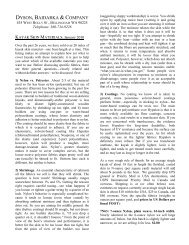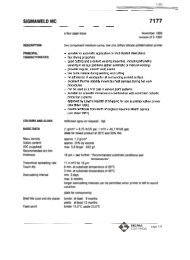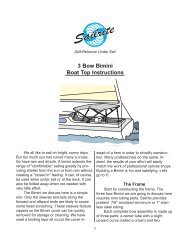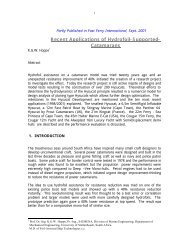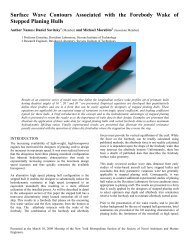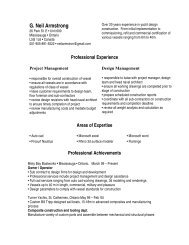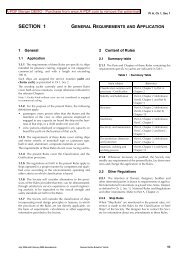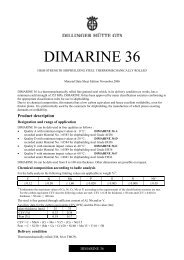CD03 - Issue #74: Designer / Builder Paul Bieker--Process Control ...
CD03 - Issue #74: Designer / Builder Paul Bieker--Process Control ...
CD03 - Issue #74: Designer / Builder Paul Bieker--Process Control ...
Create successful ePaper yourself
Turn your PDF publications into a flip-book with our unique Google optimized e-Paper software.
Resin emerges through the peel ply, butthe bleeder slows the travel so more airthan resin works its way out. Brown sayspre-preg skins would serve even better,but the setup required would be expensive,and judging from the scant amountof resin on the tossed-out peel-ply, hestill gets a lean laminate. The vacuumpump runs for eight to ten hours.The next day, Brown removes thebleeder and peel-ply and sands theskins (he doesn't trust peel-ply alone toleave a bondable surface). He's triedseveral structural core materials and currentlyuses a 5.5-lb-density (2.5 kg)Klegecell PVC foam. He's preparedcarefully shaped blanks that are kerfedto promote bending. Numerous drilledholes in the kerfs allow resin to thoroughlyfill them during layup. He buttersthe core with filled epoxy, but usesneat resin on the shear web that heinserts. After boards with spruce shearwebs broke, Brown turned to select,vertical-grain (and tightly grained)Douglas fir, which has long been airdriedand kept evenly warmed by theshop's woodstove. He completes vacuumbaggingthe assembly in the morning,and in the afternoon, carefully beginswork with the router to trim all projectionsflush with the top of the mold,checking them with a straightedge andsometimes removing lumps with a widechisel. (Since you cannot fix a nickedaluminum mold, you must repair everypart you make from a damaged one.)Brown uses a mini-grinder to closelytrim the layup that overlaps the perimetertape. Finally, with an orbital sander,he cleans up all resin around the edge,leaving clean tape.During the layup, small bubbles oftenwork their way to the edges, and Brownis careful to clean them out and to packaround the perimeter with a thickenedputty. To glue the two halves togetherafter he cuts everything flush, Brownmixes a quart and a half of epoxy thickenedwith microballoons, adds cottonfibers for strength, and applies it with awide, notch-toothed trowel. Using bigC-clamps, he begins clamping in themiddle, working his way toward theedges where pins are threaded into themolds for final clamping. The foils curefor a few clays before he pops them inthe oven, first at 90°F (22°C), then 100°Fand 110°F (37.8°C and 43.3°C) beforebacking off to 100, each for a couplehours. When the parts emerge, just apaper-thin layer of resin around theedges needs trimming. The edges areimpressively straight and the trailingedge almost dangerously sharp, yet itcontains carbon all the way to the apex.with woven carbon only 1/8" (.32 cm)inboard. None have broken so far.Brown makes notes about and numberseach foil so he can keep track ofany irregularities in the materials andtheir effect on the end product. A set ofthese foils costs on the order of $1,200—not exactly cheap, but considering thecare of the layup and the results on theracecourse, inexpensive enough suchthat demand continues to outstrip supply.He would like to find a way to automateportions of the process—the cutting,kerfing, and drilling of the coreblanks, for example—but it is likely thatsuch operations, whether for these foilsor other high-quality parts required bythe marine industry, will remain laborintensive.The good news is that, using traditionalcraftsmanship skills, some of themost sophisticated composite parts in theworld can still be made in a simple shop.—Steve CallahanDECEMBER/JANUARY 2002 83



